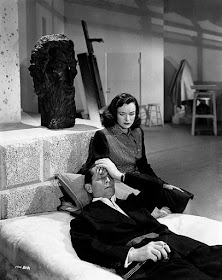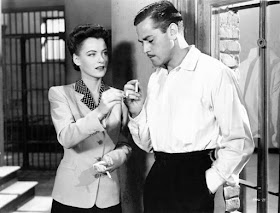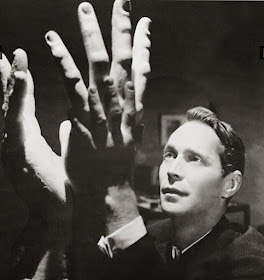 ‘Arrow Academy’ have recently released a digitally remastered edition of the 87-minute classic, ‘Phantom Lady’. It was directed by Robert Siodmak; and starred Franchot Tone, Ella Raines, and Alan Curtis. Plus, as a special bonus, it also comes with a number of additional features, including an image gallery, a full-length documentary on film-noir, as well as an hour-long radio dramatization broadcast by the Lux Radio Theatre in 1944. Please enjoy.
‘Arrow Academy’ have recently released a digitally remastered edition of the 87-minute classic, ‘Phantom Lady’. It was directed by Robert Siodmak; and starred Franchot Tone, Ella Raines, and Alan Curtis. Plus, as a special bonus, it also comes with a number of additional features, including an image gallery, a full-length documentary on film-noir, as well as an hour-long radio dramatization broadcast by the Lux Radio Theatre in 1944. Please enjoy. Phantom Lady [Arrow Academy]
THE STORY:
Excuse me. I know you don’t know who I am, but I have a sneaking suspicion that you’ve met a close, personal, friend of mine: Scott Henderson (Alan Curtis), despite him currently being sentenced to hang for murdering his own wife.
No. Don’t worry. Scott hasn’t escaped from prison and didn’t commit this crime, simply because at the time of the murder he went to see a show with a mysterious woman he picked up at a bar. Well, I say mysterious, although I suppose a better term to use would be 'hard to find'. After all, everyone who saw them together that night, acknowledges that they saw him, but denies that they ever saw her. Ranging from the bartender (Andrew Tombes), a musician (Elisha Cook Junior), and from the looks of it, even you too, (Aurora Miranda)!
Am I correct? Yes. I thought so. Which is most probably why what next transpires gets rather visceral when I say to myself, 'Carol (Ella Raines)? I wonder who can help me save Scott?'. As a mutual acquaintance shows his face - a gruff detective seems out of place - an unstable lady needs her space - and at the end of the day, please remember, an elegant hat can lead to a warm embrace.
THE REVIEW:
Now if you’re the type of person who goes to the cinema and demands realism, complicated plot-twists, and fast-paced action, then I’m afraid to say that you shouldn’t -- I repeat, shouldn’t -- watch the ‘Phantom Lady’. Otherwise, you’re going to be treated to a fairly modest murder-mystery with a cool style, an elegant edge, and a brand of acting that's very 'on the nose', so to speak.
Well, with all due respect, there were numerous times throughout this film where certain members of the cast gestated rather wildly in order to overemphasize certain emotions or plot-points. For instance, at one stage of the story, Franchot Tone's character, Jack Marlow (not to be mistaken for Raymond Chandler’s fictional detective, Philip Marlowe), waves his hands over his face and groans as if to articulate that he’s in some form of pain. Which he is, up to a point, and so would you be too, especially if you had to see him doing this for very long, Ha! Seriously though, in his defense, this style of acting was very common during the 1940s and became a mainstay throughout the entire era. Yet, when you compare it to today’s standards, it can occasionally seem somewhat difficult to take very seriously -- emotionally, at least -- and kind of detracts from the tale being told.
Come to think of it, something else that was rather distracting, annoying even, can be seen at the start of this film. Or to be more specific about it, during the introductory sequence, where we see the main character, Scott, as played by the suave Alan Curtis, walk into a bar and awkwardly pick up a complete stranger, played by the aloof Fay Helm, without even knowing her real name. I mean, seriously? Why would a man of Scott’s status -- married, owns his own business, fairly wealthy, etc -- feel the need to go out with someone who's very distant and very secretive? Particularly when you take into consideration that either side of the equation doesn't really know each other's motives or personality! As a matter of fact, during this era, it was deemed illegal for two members of the opposite sex to stay in the same hotel-room together unless they were married. So why would Scott want to take the chance when he has so much to lose?
But fear not, dear reader, because, despite my criticism, this movie is a pretty good movie, and actually manages to redeem itself due to three key ingredients. Namely, Ella Raines (who was just gorgeous to watch); it’s film-noir style (which aesthetically saved it from being just another murder-mystery); as well as its innovative approach of subverting the genre. After all, in this story the hero was a woman (not a man), the damsel in distress was a man (not a woman), and when all was said and done, everything made perfect sense in a rather topsy-turvy fashion (no spoilers here, folks). Another shout out should also go to the smartly composed camerawork and the atmospheric lighting on display, the both of which elevated the tone of this film so much that it was easy to overlook some of its many, many flaws. Heck, just take a look at the video clip or the images provided, and see for yourself how the filmmakers took a scholarly approach to its visual construction.
Anyway, that’s enough of that for now, as this seems like a pretty good time for us to sit back, relax, and check out the following filmic facts: (1) ‘Universal Pictures’ first released this production in America on the exact same day Omar Bradley took command of the First United States Army. It was on the 28th of January, 1944. (2) This film was loosely based on a novel written by Cornell Woolrich in 1942, keeping in mind that he wrote it under his pseudonym, William Irish. (3) Loosely translated, this project was called ‘Death Cannot Testify’ in Sweden; ‘Blind Because Of’ in the Netherlands; and during post-production, it was given the working title, ‘Condemned to Hang’. (4) The majority of this movie was shot inside ‘Universal Studios’, located at 100 Universal City Plaza, Universal City, California, USA. (5) One of the taglines used to promote this picture, states, ‘The most talked about mystery in ten years!’. (6) Two months after this movie was released -- March the 27th, 1944 -- most of the cast reprised their roles for the radio version of this adventure, broadcast on the Lux Radio Theater. (7) According to his son, Dave Coleman performed Elisha Cook Jr.'s erotic drum solo for this film. Although, other sources claim that it was performed by Buddy Rich, despite Rich himself disputing this fact because he was busy with other work at the time. (8) After this flick faded into the mist, Franchot Tone starred in the wartime drama, ‘The Hour Before the Dawn’; Ella Raines starred in the patriotic comedy, ‘Hail the Conquering Hero’; and Alan Curtis starred in the horror sequel, ‘The Invisible Man's Revenge’.
In closing my review for the 'Phantom Lady', I would just like to pose one simple question: Should this film be classified as a film-noir? Well, personally speaking, I’m not entirely sure, because according to certain sources this genre began with the Humphrey Bogart, Peter Lorre, and Sydney Greenstreet classic, ‘The Maltese Falcon’, circa 1941, and ended with another classic, ‘Touch of Evil’, starring Orson Welles, Charlton Heston, and Janet Leigh, circa 1958, and usually involves a black and white story where a femme fatale corrupts a working-class stiff. So, if this were true, and the two main protagonists have to be gender specific, then this film isn’t a film-noir because the villain was a man, the hero was a woman, and the adventure itself seemed more obvious and less complex.
That said, however, there is another train of thought which defines film-noir as a brand, a style, and a tonal aesthetic, rather than being a formula for a 'grim and gritty' storyline. Therefore, if this were true instead, then yes, this film is a film-noir, guaranteed, as it is a very stylized film with a duplicitous storyline, a broad style of acting, and a hyper-nuanced approach to cinematography! Similar, in fact, to a vintage comic book created by someone like Will Eisner, for instance, who’s generally best known for constructing bold murder mysteries involving sassy females and confused men.
Now, while I’m on the subject of comic books, did you know that one of the first ever female superheroes was called Phantom Lady (real name, Sandra Knight) and that she made her comic book debut in Police Comics #1, cover dated August, 1941? Although, as far as I’m concerned, there will only ever be one real Phantom Lady, Ella Raines, who I thought was just magnificent and stole the show, what with her seductive elegance, her graceful style, and her piercing Rita Hayworth eyes. Her co-stars weren’t too bad either, but as I said before, sometimes some of them seemed a bit too 'on the nose' to take very seriously. So, with all that said, overall I’d like to say that this was a pretty neat film and it’s definitely well worth a watch if you’re a fan of nostalgia, noir, and sexy women.
THE RATING: B-
PHANTOM LADY (1944)
 Reviewed by David Andrews
on
March 04, 2019
Rating:
Reviewed by David Andrews
on
March 04, 2019
Rating:
 Reviewed by David Andrews
on
March 04, 2019
Rating:
Reviewed by David Andrews
on
March 04, 2019
Rating:








No comments:
Post a Comment